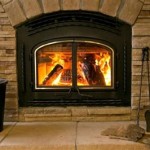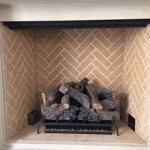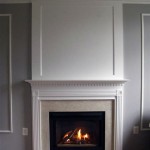Understanding the Allure of Antique Cast Iron Fireplace Surrounds
Antique cast iron fireplace surrounds represent a significant element of architectural and social history. These surrounds, often dating back to the Victorian, Edwardian, and even earlier periods, are not simply decorative; they are tangible links to past eras, reflecting the craftsmanship, design sensibilities, and heating technologies of their time. Understanding their value, identifying authentic pieces, and appreciating their historical context is crucial for collectors, homeowners, and interior designers alike.
The term "fireplace surround" encompasses the decorative facing around a fireplace opening. It typically includes the mantelpiece, jambs (the vertical sides), and overmantel (if present). Cast iron, chosen for its durability, heat resistance, and ability to be intricately molded, became a popular material for fireplace surrounds during the 18th and 19th centuries. The Industrial Revolution facilitated mass production, making cast iron more accessible and affordable for a wider range of households. This period saw an explosion of designs, from simple geometric patterns to elaborate depictions of classical figures, foliage, and mythical creatures.
These surrounds served a dual purpose: they provided a practical framework for the fireplace opening, protecting the surrounding wall from heat and soot, while simultaneously enhancing the aesthetic appeal of the room. The design often reflected the social status and personal taste of the homeowner. An intricately detailed surround, for instance, could signal wealth and sophistication, while a simpler design might indicate a more modest lifestyle. The evolution of fireplace surround design mirrors the broader stylistic trends of the time, offering valuable insights into the history of art, architecture, and interior design.
Recognizing Features of Authentic Antique Cast Iron Fireplace Surrounds
Determining the authenticity of an antique cast iron fireplace surround requires careful observation and a degree of background knowledge. Several features distinguish genuine antiques from reproductions or later imitations. The weight of the cast iron is a significant indicator. Antique cast iron tends to be heavier than modern reproductions due to the casting techniques and materials used. Earlier foundries often used thicker metal and less refined casting processes, resulting in a denser and more substantial feel.
Surface texture is another key characteristic. Authentic pieces will often exhibit a slight roughness or imperfections in the casting. This is a result of the sand casting process, where molten iron is poured into a mold made from sand. Minute imperfections in the sand mold can translate to the surface of the cast iron. Modern reproductions, produced with more advanced casting methods, typically have a smoother, more uniform surface. However, genuine antiques are not always perfectly smooth; some might have been filed down or modified over time.
Look for signs of age, such as patina and wear. Patina is a natural discoloration that develops on the surface of the metal over time due to oxidation and exposure to the environment. It can manifest as a subtle darkening, a reddish-brown hue, or even a greenish tinge. While patina can be artificially created, a genuine patina will have a natural, uneven appearance, often concentrated in crevices and protected areas. Wear marks, such as scratches, dents, and areas where the paint has worn away, can also indicate age and use. However, excessive damage might detract from the value of the surround.
Examine the design and detailing closely. Antique surrounds often feature intricate details and elaborate decorations that are difficult to replicate accurately. The quality of the casting and the sharpness of the details are important indicators of craftsmanship. Look for crisp lines, well-defined motifs, and a general sense of refinement. Reproductions often lack the same level of detail and may appear somewhat crude or simplified. Researching the design styles prevalent during different historical periods can help determine the age and authenticity of the surround. For example, a surround featuring intricate floral motifs and flowing lines is more likely to be from the Victorian era, while a surround with geometric patterns and clean lines might be from the Art Deco period.
Check for markings and manufacturer's stamps. Some antique cast iron fireplace surrounds bear the mark of the foundry or manufacturer that produced them. These markings can provide valuable information about the origin and age of the piece. They may be stamped, cast, or even painted onto the surface of the iron. However, the absence of a marking does not necessarily indicate that the surround is not authentic. Many foundries did not consistently mark their products, and some markings may have been lost over time due to wear and corrosion.
Understanding the Historical Context and Design Styles
The design of antique cast iron fireplace surrounds evolved significantly over time, reflecting changing tastes and technological advancements. Examining the historical context in which a surround was created can provide insights into its value and significance. During the late 18th and early 19th centuries, Neoclassical designs, inspired by ancient Greek and Roman art and architecture, were popular. These surrounds often featured symmetrical designs, fluted columns, and depictions of classical figures and motifs. Simplicity and elegance were key characteristics of this style.
The Victorian era (1837-1901) saw an explosion of decorative styles, ranging from the elaborate and ornate to the more restrained and functional. Gothic Revival, with its pointed arches, trefoils, and references to medieval architecture, was a prominent influence. Rococo Revival, characterized by asymmetrical designs, scrolling foliage, and shell motifs, was also popular. Later in the Victorian era, the Aesthetic Movement emphasized beauty and artistry for their own sake. Fireplace surrounds from this period often featured intricate floral designs, Japanese-inspired motifs, and unconventional color palettes.
The Edwardian era (1901-1910) marked a shift towards lighter, more airy designs. Fireplace surrounds from this period often featured simpler lines, pastel colors, and decorative elements inspired by nature. The Art Nouveau movement, with its flowing lines, organic forms, and emphasis on craftsmanship, also influenced fireplace design. Although relatively short, the Edwardian period is particularly important in the development of fireplace surround designs, bridging the gap between the elaborate excess of the Victorian era and the cleaner, more functional aesthetic of the 20th century.
The Art Deco period (1920s-1930s) brought a new level of sophistication and glamour to fireplace design. Art Deco surrounds often featured geometric patterns, streamlined shapes, and luxurious materials such as chrome, black lacquer, and marble. The style emphasized modernity, technology, and the machine age. These surrounds often reflected the architectural trends of the time, incorporating elements of skyscrapers, automobiles, and other symbols of modern life.
The scarcity of a particular style may influence its value. Surrounds from shorter-lived periods, such as those reflecting specific artistic movements, or those manufactured by foundries with limited production runs, are often more sought-after by collectors. However, it is important to remember that the overall condition, provenance, and aesthetic appeal of the surround also play a significant role in determining its value.
Maintaining and Restoring Antique Cast Iron Fireplace Surrounds
Preserving the integrity of an antique cast iron fireplace surround requires careful maintenance and, in some cases, restoration. The decision to restore a surround should be approached with caution, as improper techniques can damage the piece and diminish its value. Before undertaking any restoration work, it is important to assess the condition of the surround and determine the extent of the necessary repairs. Minor damage, such as surface rust or chipped paint, can often be addressed with simple cleaning and touch-up techniques. More significant damage, such as cracks, broken castings, or extensive corrosion, may require professional restoration services.
Cleaning an antique cast iron fireplace surround should be done gently, using mild soap and water. Avoid harsh chemicals, abrasive cleaners, or scouring pads, as these can scratch the surface and remove the patina. A soft cloth or brush can be used to remove dirt and dust. For stubborn stains, a paste made from baking soda and water can be applied, but it should be rinsed off thoroughly after a short period.
Removing rust requires a delicate approach. Surface rust can often be removed with a wire brush or steel wool, but care should be taken not to scratch the underlying metal. A rust converter can be applied to neutralize the rust and prevent it from spreading. For more extensive corrosion, professional rust removal techniques, such as sandblasting or chemical stripping, may be necessary. However, these methods should be used sparingly, as they can alter the surface of the iron and remove the patina.
Repainting an antique cast iron fireplace surround can enhance its appearance and protect it from further corrosion. However, it is important to choose the right type of paint. Traditional paints, such as oil-based paints, are often preferred for their durability and authentic appearance. However, modern acrylic paints can also be used, as long as they are compatible with the cast iron and designed for high-temperature applications. The surface should be thoroughly cleaned and primed before painting. Multiple thin coats of paint are preferable to a single thick coat, as this will prevent drips and runs. The color of the paint should be chosen carefully, taking into account the original color of the surround and the style of the room.
Repairing cracks and broken castings requires specialized skills and knowledge. Welding is a common method for repairing cast iron, but it must be done carefully to avoid warping or damaging the metal. Professional restorers often use specialized welding techniques, such as TIG welding or stick welding, to ensure a strong and durable repair. Missing castings can be replaced with new or salvaged parts, but it is important to match the original design and material as closely as possible. The repair should be seamless and virtually invisible.
Reinstalling an antique cast iron fireplace surround should be done with care and precision. The surround should be properly secured to the wall to prevent it from falling or shifting. If the surround is being installed in a working fireplace, it is important to ensure that it is properly ventilated to prevent overheating. A professional fireplace installer can provide guidance and assistance with the installation process.
Proper maintenance and restoration can help preserve the beauty and historical value of antique cast iron fireplace surrounds for generations to come. Owners should prioritize gentle cleaning over aggressive interventions and seek professional advice when faced with significant damage or complex restoration challenges. By understanding the materials, techniques, and historical context involved, owners can ensure that these valuable pieces of architectural history are properly cared for.

Antique Cast Iron Fireplace Surround

Antique Late Victorian Cast Iron Fireplace Surround Nostalgia

Vintage Cast Iron Fireplace Insert Surround Sold Separately Watling Reclamation

Antique Cast Iron Fireplace Surround East End Salvage

Victorian Cast Iron Tall Fireplace Surround Westland Antiques

Antique Fireplaces London International Available

Intricate Cast Iron Fireplace Surround For Victorian

Antique Salvaged Cast Iron Fireplace Mantel

Antique Vintage Ornate Heavy Cast Iron Fireplace Surround Star 29 5 T X 22

Empire Cast Iron Fireplace Surround Architectural Salvage Hudson Valley House Parts
Related Posts








